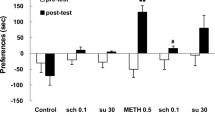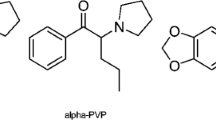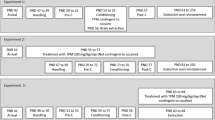Abstract
Previous research from our laboratory suggests that low doses (<0.1 mg/kg) of the dopamine (DA) D3-preferring agonist 7-hydroxy-N,N-di-n-propyl-2-aminotetralin (7-OH-DPAT) attenuate conditioned place preference (CPP) produced by the indirect DA agonist d-amphetamine, but enhance d-amphetamine-induced stereotypic behaviors. This study further examined the effects of 7-OH-DPAT on behaviors produced by the indirect DA agonist, cocaine, and the non-selective direct DA agonist, apomorphine. To examine whether 7-OH-DPAT would alter cocaine and apomorphine dose-response curves for motor behaviors and CPP, 0.1 mg/kg 7-OH-DPAT was co-administered with 0–30 mg/kg cocaine and 0–3 mg/kg apomorphine. To establish place conditioning, drug injections were paired with one of two distinctly different compartments, whereas saline injections were paired with the other compartment. Locomotion, sniffing, oral stereotypy, and headbobbing were measured following acute and repeated drug administration during conditioning, and place conditioning was assessed 24 h following the last conditioning day.7-OH-DPAT enhanced cocaine- and apomorphine-induced stereotypies following repeated administration. 7-OH-DPAT also attenuated cocaine-CPP, but potentiated apomorphine-CPP. Furthermore, 7-OH-DPAT attenuated locomotion produced by high doses of apomorphine. The attenuation of cocaine-CPP by 7-OH-DPAT likely involves stimulation of D2/D3 autoreceptors in the mesolimbic pathway, whereas the potentiation of apomorphine-CPP likely involves stimulation of D2/D3 postsynaptic receptors. Furthermore, it is suggested that attenuation of apomorphine-induced locomotion by 7-OH-DPAT likely involves stimulation of postsynaptic D3 receptors in the mesolimbic pathway. Thus, if postsynaptic D3 receptors are involved in mediating CPP and locomotion, then stimulation of D3 receptors may facilitate CPP but inhibit locomotion.
Similar content being viewed by others
Author information
Authors and Affiliations
Additional information
Received: 20 May 1998 / Final version: 17 September 1998
Rights and permissions
About this article
Cite this article
Khroyan, T., Fuchs, R., Beck, A. et al. Behavioral interactions produced by co-administration of 7-OH-DPAT with cocaine or apomorphine in the rat. Psychopharmacology 142, 383–392 (1999). https://doi.org/10.1007/s002130050903
Issue Date:
DOI: https://doi.org/10.1007/s002130050903




